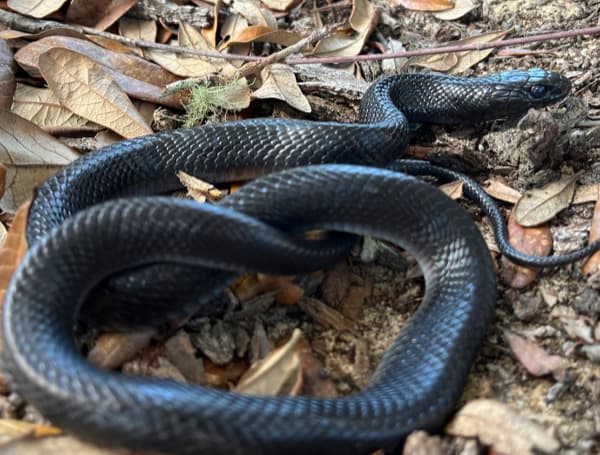In a quiet preserve along the eastern bank of the Apalachicola River, 41 eastern indigo snakes were released Tuesday into gopher tortoise burrows.
The release, a longtime goal of federal and state officials, is part of an effort to restore some balance to Florida’s ecosystem lost in the 1980s as development limited eastern indigo snakes’ range and people hunted for other prey, primarily rattlesnakes but also gopher tortoises. Eastern indigo snakes are a federally designated threatened species.
“We’re just providing assurance that the population will continue to grow,” said Brad O’Hanlon, coordinator of the Florida Fish and Wildlife Conservation Commission’s reptile and amphibian conservation efforts.
Read: FWC: Florida Snakes Are On The Move
“And hopefully, we’ll be at a point where we don’t have to do this anymore,” O’Hanlon continued before the release at The Nature Conservancy’s Apalachicola Bluffs and Ravines Preserve. The preserve is the only place in Florida where eastern indigo snakes are being reintroduced.
Non-venomous, the bluish-black snakes can reach lengths of eight feet. Those released Tuesday were mostly about 3 feet long and 2 years old, after being raised at the Central Florida Zoo’s Orianne Center for Indigo Conservation.
“They’ll hopefully thrive out here and get to be closer to that full size,” Catherine Ricketts, manager of The Nature Conservancy’s preserve, said.
The snakes are considered indiscriminate eaters, with an ability to overpower other snakes.
“Their favorite flavor of snake is venomous snakes,” James Bogan, director of the Orianne Center for Indigo Conservation, said. “That’s their jam. They just want to eat venomous snakes.”
Read: Florida Spring Brings Bats, Bears, Snakes, And More
Along with efforts at the Northwest Florida preserve, restoration under the guidance of the U.S. Fish and Wildlife Service is also ongoing in Alabama’s Conecuh National Forest, just north of the Florida state line.
The Nature Conservancy, the Florida Fish and Wildlife Conservation Commission, the Central Florida Zoo and the U.S. Fish and Wildlife Service have been coordinating releases at the Florida preserve for eight years.
Tuesday’s was the largest and helped exceed the halfway mark of the U.S. Fish and Wildlife Service’s goal of 300 snakes being released in the region.
O’Hanlon said a positive sign that the snakes are taking hold is that two hatchling indigo snakes were found at the preserve last fall.
“Having them on the landscape just shows that you have a complete ecosystem. … all the functional parts are there,” O’Hanlon said. “And that’s the landscape that we want in North Florida. That’s our historic landscape. And that’s what we’re trying to maintain.”
Help support the Tampa Free Press by making any small donation by clicking here.
Android Users, Click To Download The Tampa Free Press App And Never Miss A Story. Follow Us On Facebook and Twitter. Sign up for our free newsletter.


